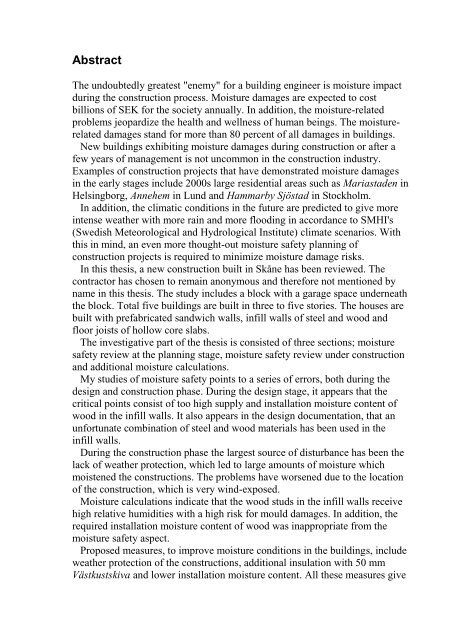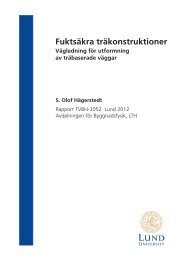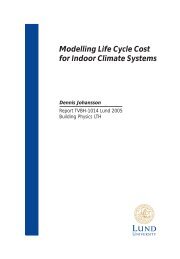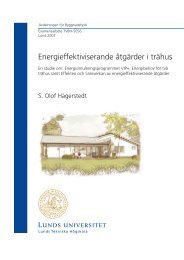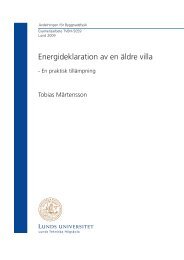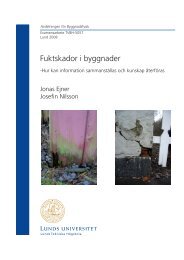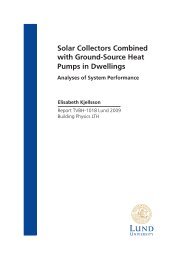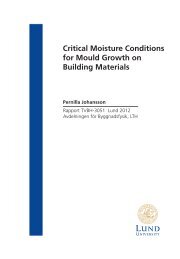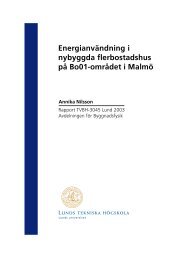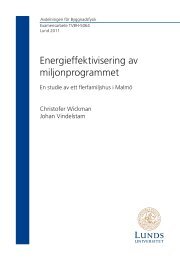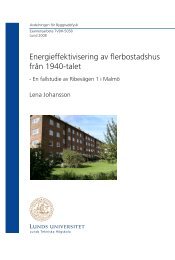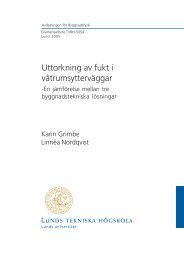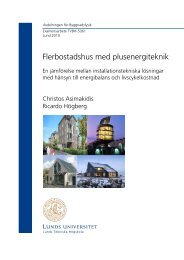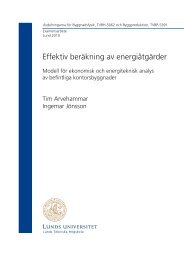Fuktsäkerhetsgranskning av nybyggnation - Byggnadsfysik - Lunds ...
Fuktsäkerhetsgranskning av nybyggnation - Byggnadsfysik - Lunds ...
Fuktsäkerhetsgranskning av nybyggnation - Byggnadsfysik - Lunds ...
Create successful ePaper yourself
Turn your PDF publications into a flip-book with our unique Google optimized e-Paper software.
Abstract<br />
The undoubtedly greatest "enemy" for a building engineer is moisture impact<br />
during the construction process. Moisture damages are expected to cost<br />
billions of SEK for the society annually. In addition, the moisture-related<br />
problems jeopardize the health and wellness of human beings. The moisturerelated<br />
damages stand for more than 80 percent of all damages in buildings.<br />
New buildings exhibiting moisture damages during construction or after a<br />
few years of management is not uncommon in the construction industry.<br />
Examples of construction projects that h<strong>av</strong>e demonstrated moisture damages<br />
in the early stages include 2000s large residential areas such as Mariastaden in<br />
Helsingborg, Annehem in Lund and Hammarby Sjöstad in Stockholm.<br />
In addition, the climatic conditions in the future are predicted to give more<br />
intense weather with more rain and more flooding in accordance to SMHI's<br />
(Swedish Meteorological and Hydrological Institute) climate scenarios. With<br />
this in mind, an even more thought-out moisture safety planning of<br />
construction projects is required to minimize moisture damage risks.<br />
In this thesis, a new construction built in Skåne has been reviewed. The<br />
contractor has chosen to remain anonymous and therefore not mentioned by<br />
name in this thesis. The study includes a block with a garage space underneath<br />
the block. Total five buildings are built in three to five stories. The houses are<br />
built with prefabricated sandwich walls, infill walls of steel and wood and<br />
floor joists of hollow core slabs.<br />
The investigative part of the thesis is consisted of three sections; moisture<br />
safety review at the planning stage, moisture safety review under construction<br />
and additional moisture calculations.<br />
My studies of moisture safety points to a series of errors, both during the<br />
design and construction phase. During the design stage, it appears that the<br />
critical points consist of too high supply and installation moisture content of<br />
wood in the infill walls. It also appears in the design documentation, that an<br />
unfortunate combination of steel and wood materials has been used in the<br />
infill walls.<br />
During the construction phase the largest source of disturbance has been the<br />
lack of weather protection, which led to large amounts of moisture which<br />
moistened the constructions. The problems h<strong>av</strong>e worsened due to the location<br />
of the construction, which is very wind-exposed.<br />
Moisture calculations indicate that the wood studs in the infill walls receive<br />
high relative humidities with a high risk for mould damages. In addition, the<br />
required installation moisture content of wood was inappropriate from the<br />
moisture safety aspect.<br />
Proposed measures, to improve moisture conditions in the buildings, include<br />
weather protection of the constructions, additional insulation with 50 mm<br />
Västkustskiva and lower installation moisture content. All these measures give


